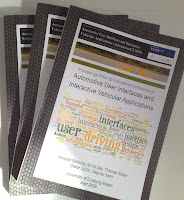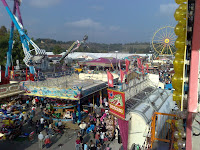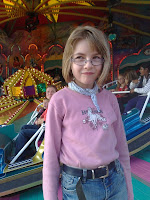 At the evening event of MobileHCI2009 the best paper awards were presented. The best short paper was „User expectations and user experience with different modalities in a mobile phone controlled home entertainment system“ [1]. There were two full papers that got a best paper award: „Sweep-Shake: finding digital resources in physical environments“ [2] and „PhotoMap: using spontaneously taken images of public maps for pedestrian navigation tasks on mobile devices“ [3]. We often look at best papers of a conference to better understand what makes a good paper for this community. All of the 3 papers above are really well done and worthwhile to read.
At the evening event of MobileHCI2009 the best paper awards were presented. The best short paper was „User expectations and user experience with different modalities in a mobile phone controlled home entertainment system“ [1]. There were two full papers that got a best paper award: „Sweep-Shake: finding digital resources in physical environments“ [2] and „PhotoMap: using spontaneously taken images of public maps for pedestrian navigation tasks on mobile devices“ [3]. We often look at best papers of a conference to better understand what makes a good paper for this community. All of the 3 papers above are really well done and worthwhile to read.
PhotoMap [3] is a simple but very cool idea. Many of you have probably taken photos of public maps with your mobile phone (e.g. at a park, city map) and PhotoMap explores how to link them to realtime location data from the GPS on the device. The goal is that you can move around in the real space and you have a dot marking where you are on the taken photo. The implementation however seems not completely simple… There is a youtube movie on PhotoMap (there would be more movies from the evening event – but I do not link them here – the photo above gives you an idea…)
 Since last year there is also a history best paper award (most influential paper from 10 years ago). Being at the beginning of a new field sometimes pays of… I got this award for the paper on implicit interaction [4] I presented in Edinburgh at MobileHCI 1999.
Since last year there is also a history best paper award (most influential paper from 10 years ago). Being at the beginning of a new field sometimes pays of… I got this award for the paper on implicit interaction [4] I presented in Edinburgh at MobileHCI 1999.
[1] Turunen, M., Melto, A., Hella, J., Heimonen, T., Hakulinen, J., Mäkinen, E., Laivo, T., and Soronen, H. 2009. User expectations and user experience with different modalities in a mobile phone controlled home entertainment system. In Proceedings of the 11th international Conference on Human-Computer interaction with Mobile Devices and Services (Bonn, Germany, September 15 – 18, 2009). MobileHCI ’09. ACM, New York, NY, 1-4. DOI= http://doi.acm.org/10.1145/1613858.1613898
[2] Robinson, S., Eslambolchilar, P., and Jones, M. 2009. Sweep-Shake: finding digital resources in physical environments. In Proceedings of the 11th international Conference on Human-Computer interaction with Mobile Devices and Services (Bonn, Germany, September 15 – 18, 2009). MobileHCI ’09. ACM, New York, NY, 1-10. DOI= http://doi.acm.org/10.1145/1613858.1613874
[3] Schöning, J., Krüger, A., Cheverst, K., Rohs, M., Löchtefeld, M., and Taher, F. 2009. PhotoMap: using spontaneously taken images of public maps for pedestrian navigation tasks on mobile devices. In Proceedings of the 11th international Conference on Human-Computer interaction with Mobile Devices and Services (Bonn, Germany, September 15 – 18, 2009). MobileHCI ’09. ACM, New York, NY, 1-10. DOI= http://doi.acm.org/10.1145/1613858.1613876
[4] Albrecht Schmidt. Implicit human computer interaction through context. Personal and Ubiquitous Computing Journal, Springer Verlag London, ISSN:1617-4909, Volume 4, Numbers 2-3 / Juni 2000. DOI:10.1007/BF01324126, pp. 191-199 (initial version presented at MobileHCI1999). http://www.springerlink.com/content/u3q14156h6r648h8/
The Auto-UI 2009 conference in Essen is over – and for us it was very enjoyable to have this many visitors at the University of Duisburg-Essen – see the photos. The conference facilitated good discussions and had a very constructive atmosphere. We should continue this exchange of ideas and there is always room for improvement… and that is why there is a Auto-UI conference 2010 in Pittsburgh, US – and there is interest beyond this in hosting the conference.














